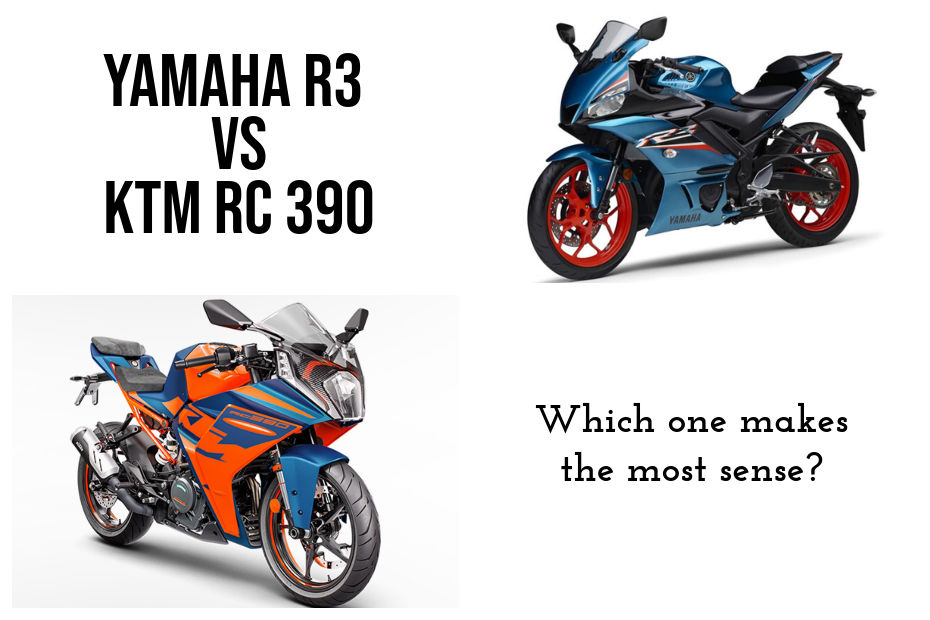In 10 Pics: Yamaha R3 Vs KTM RC 390 - Differences Explained
Modified On Apr 19, 2023 09:01 AM By Sudipto Chaudhury for Yamaha R3
- 1874 Views
- Write a comment
KTM’s track missile goes head-to-head with the R15’s bigger sibling

The KTM RC 390 has been the ultimate track weapon of sorts, with the next logical step up for most riders being their first multi-cylinder machine. However, this monopoly was disturbed slightly between 2015 and 2019 when the Yamaha R3 was on sale here. And come July 2023, and the R3 is set to make a comeback. So how does it compare with the new-age RC 390? Here’s a visual reckoner:
Engine and performance


Starting off, the two bikes make comparable power figures: 43PS from the KTM’s 373.2cc thumper, 42PS from the Yamaha’s 321cc mill twin. The torque figures are a good deal different, though, with the RC making 37Nm, and the R3 making 29.7Nm. Dig deeper, though, and you’ll realise that since their bikes last sparred, the KTM’s engine has been extensively reworked, almost nudging the twin-cylinder space.
But that’s not all; though both have a six-speed gearbox, the KTM’s quickshifter and slip-and-assist clutch give it the upper hand.
Visuals


Call it a scaled-up version of the Yamaha R15S, or a scaled-down R6, the R3’s timeless design, with the twin LED headlights, sharp fairing, slim outline and sharp tail give it an attractive silhouette. The RC 390, meanwhile, has a polarising design, with a slab-faced front, bulky fascia, and sharp tail, albeit one with a conventionally wide two-piece grabrail. That said, some thoughtful inclusions on the RC 390, such as the grippy, alcantara-like seat material, and adjustable handlebars, which should make it more versatile for both commutes as well riding on track.
Underpinnings and mechanicals


The chassis on both are vastly different: while the Yamaha gets a deltabox unit, the KTM has a trellis frame. Both get similar USD forks and monoshocks, the latter getting both preload and rebound adjustment. That said, while the Yamaha has a linked monoshock for a more pliant ride, the KTM’s unit is directly mounted to the swingarm.
Both also get 17-inch alloys, with the front wrapped in a 110-section tyre, though the KTM’s 150-section rear is wider than the Yamaha’s 140-section unit. And finally, though both get discs front and rear with dual-channel ABS, the KTM has a clear upper hand, with the KTM’s 320mm front and 230mm disc uniformly larger than the Yamaha’s 298mm front and 220mm rear units.
Features


This is another space where the KTM is clearly ahead. As mentioned, the KTM gets a quickshifter, which the Yamaha doesn’t. Next, while the Yamaha sports an LCD instrument console, the KTM has a smartphone-compatible TFT cluster with call and message alerts and music selection, though no navigation. Moreover, the R3 has dual-channel ABS and not much else, while the 390 Duke gets cornering ABS (a segment first) along with two ABS modes (dual-channel, and rear switched off or ‘supermoto’).
Price and availability


The KTM RC 390 is currently on sale, retailing at Rs 3,16,070 (ex-showroom Delhi), the Yamaha R3, meanwhile, is slated to launch by July 2023 with a price tag of Rs 4 lakh. That said, while KTM’s dealership network is quite extensive, the R3 will only be available in Yamaha’s premier Blue Square dealerships.
